-
Posts
578 -
Joined
-
Last visited
Content Type
Profiles
Forums
Store
Help Articles
Posts posted by Keith_W
-
-
This sounds interesting, but a search didn't help me find more details unfortunately. Could someone point me in the right direction please?Keith_W's popcorn salad
That's because I invented it
 So far everyone whom i've served it to seems to want to know the recipe, which is a good sign!
So far everyone whom i've served it to seems to want to know the recipe, which is a good sign!-
 2
2
-
-
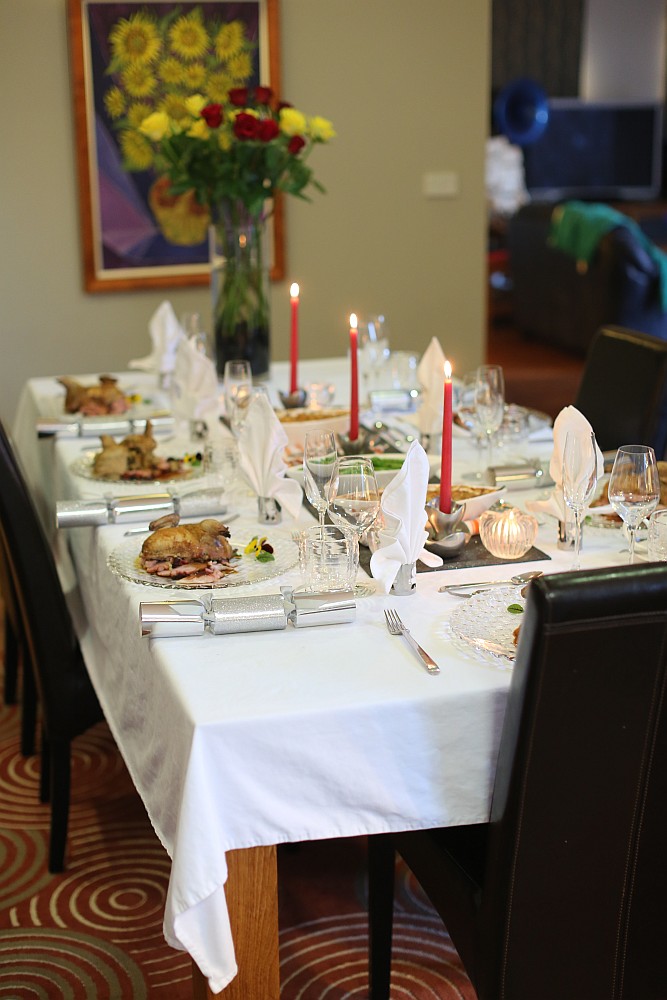 Christmas eve dinner at my place. All set up with Christmas crackers.
Christmas eve dinner at my place. All set up with Christmas crackers.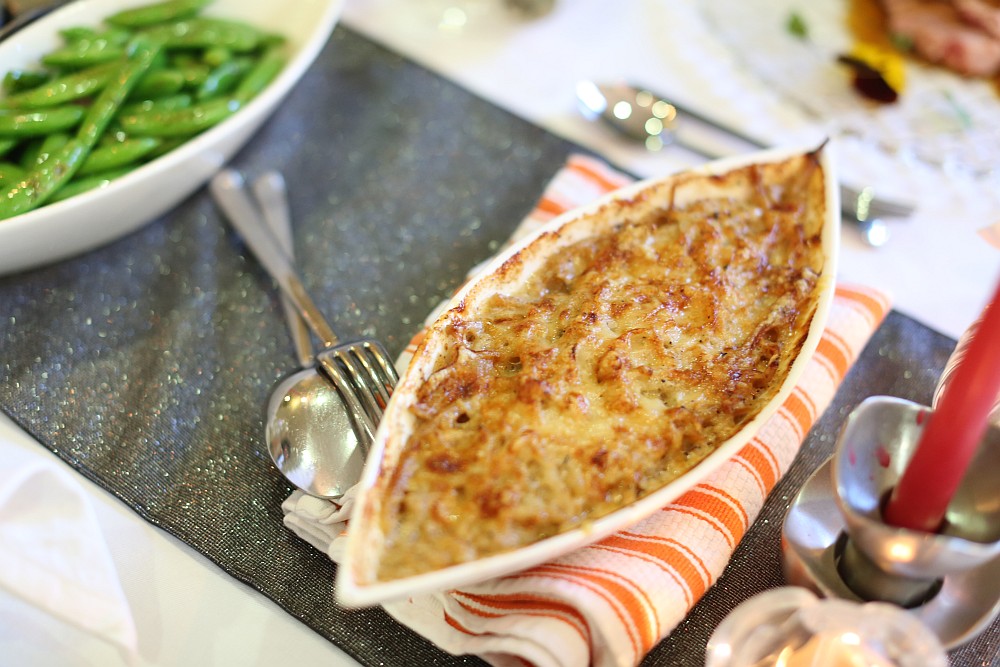 Jansson's Temptation - a Swedish potato gratin. The difference is that it is made with onions and sprats. Instead of using breadcrumbs, I used Gruyere.
Jansson's Temptation - a Swedish potato gratin. The difference is that it is made with onions and sprats. Instead of using breadcrumbs, I used Gruyere.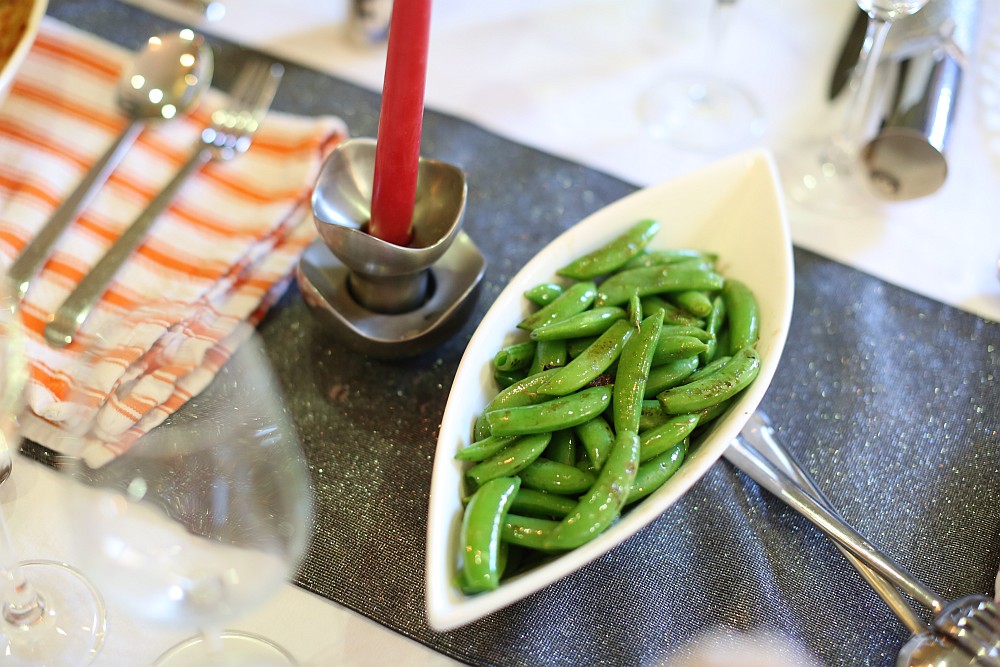 Sugar snap peas with anchovies and whiskey.
Sugar snap peas with anchovies and whiskey.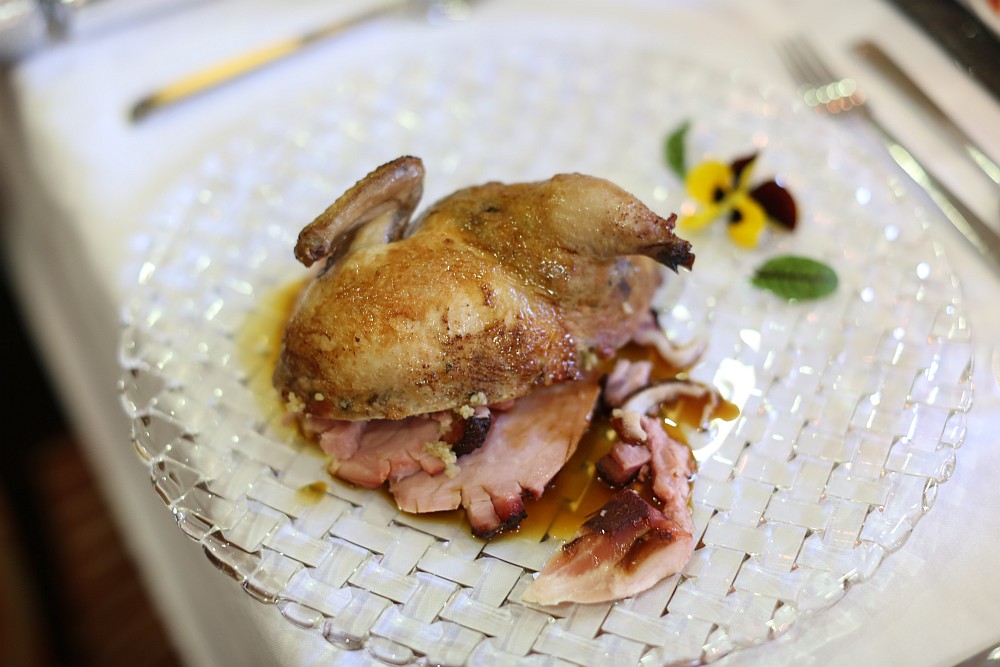 The main course - tunnel boned Poussin stuffed with couscous and briefly smoked, shaved smoked ham, turkey jus.
The main course - tunnel boned Poussin stuffed with couscous and briefly smoked, shaved smoked ham, turkey jus.
-
 6
6
-
-
Oops this post might be a little late for you now. Take all the guesswork out of whether your meat is done - use a meat thermometer and cook till your prime rib is 55C for medium rare. You might want to consider setting your oven to 60C, roasting for 4-5 hours, checking the temperature of the meat every 30 mins after 3 hours. Turn the oven off when it hits 53C. Before serving, panfry the entire roast to develop colour on the surface.
-
 1
1
-
-
Did you manage to find pork nipples for Heston's pork scratchings?
-
Oh, so you did decide to spend Christmas with your parents! You poor thing

My favourite cheap eats places in Sydney are Super Bowl in Chinatown (go there for breakfast or supper), and Golden Palace. Din Tai Fung is also quite good.
-
Yes i've made that Heston batter as well. I don't seem to have a picture of my last attempt, but it REALLY puffs up - my piece of fillet ended up three times the size, and really crunchy as well - almost too crunchy. I tend to prefer Flathead fillets - I buy it from the local fishmonger at Camberwell markets.
OTOH there is no good F&C shop nearby

-
Could you provide a little more detail about "icing the breasts"? I think I understand, but not completely.
From Harold McGee, via NPR's Terry Gross:
MCGEE: Take the bird out ahead of time and let the legs warm up a little bit while you keep the breasts covered with ice packs. That way, you keep the breasts cold. The legs warm up by maybe 10, 20 degrees, and that way, when you put the bird in the oven, you've already built in a temperature differential. The breasts are going to end up, at a given time, less-cooked than the legs. And that's exactly what you want.
I hope that helps. Mrs. C used ice cubes in plastic baggies.
That's the technique I use as well.
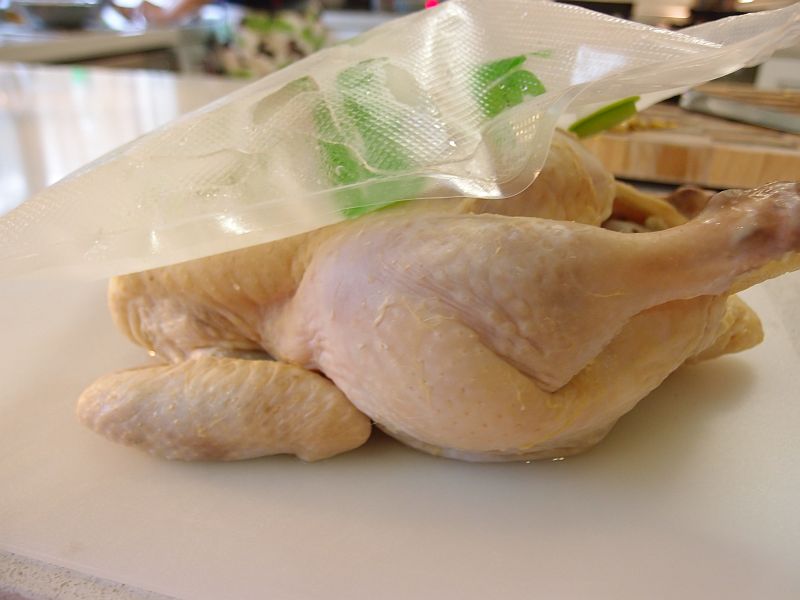
-
 2
2
-
-
[]David Ross when I saw your pork confit I lost my breath too. May I ask which Keller book this is from? I don't seem to recall seeing the recipe.
-
sigma, that's interesting. Do you know the type of sutures that they use? Do they make interrupted or continuous stitches? I used 2-0 silk, interrupted. I normally use 3-0 or finer, but I couldn't get hold of that this time.
-
 1
1
-
-
I made these couscous stuffed poussins for a friend's dinner party. This is why the plates are different to my standard plates (if anyone is keeping track!).
To my knowledge, nobody is crazy enough to consider tunnel boning a poussin, then stuffing it, then suturing it so that it appears whole, and then injecting it with sauce and roasting it. It is a lot of work, I had to do 10 of these little bastards. I also forgot to bring my suture holder, which meant that I was MUCH slower at suturing and more wasteful of sutures than I normally am.
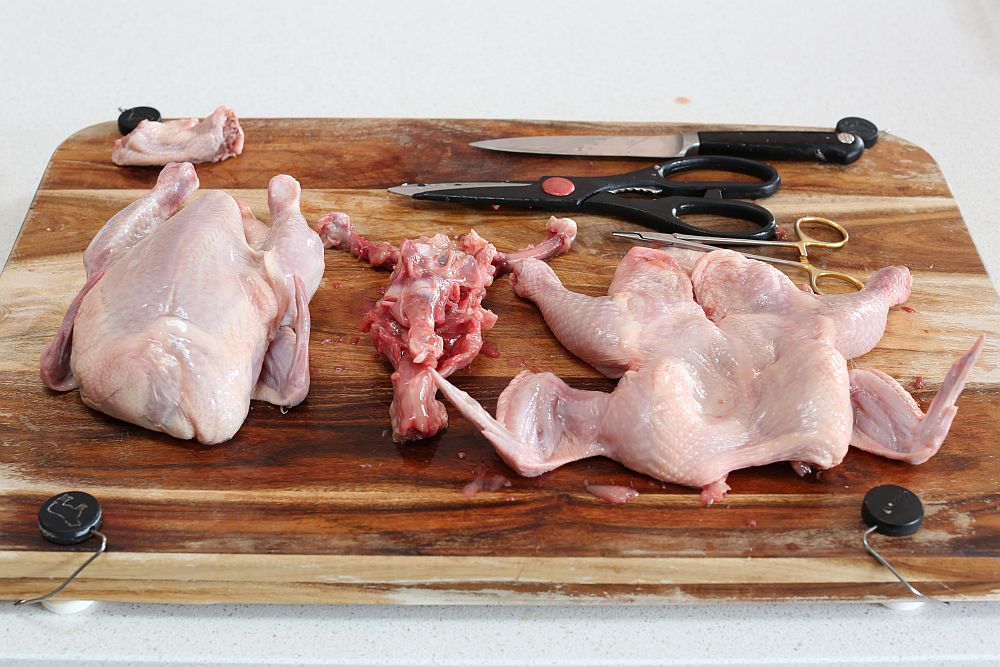
I didn't take a picture of the tunnel boning process this time, but here is an older photo showing a tunnel boned poussin on the right.
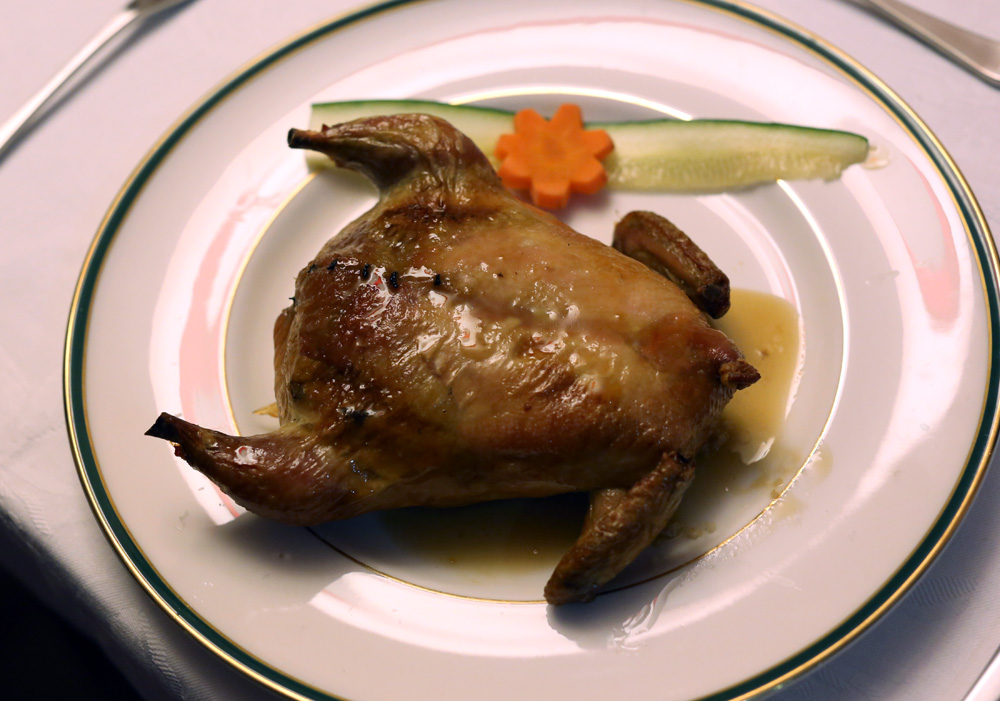
One completed bird.
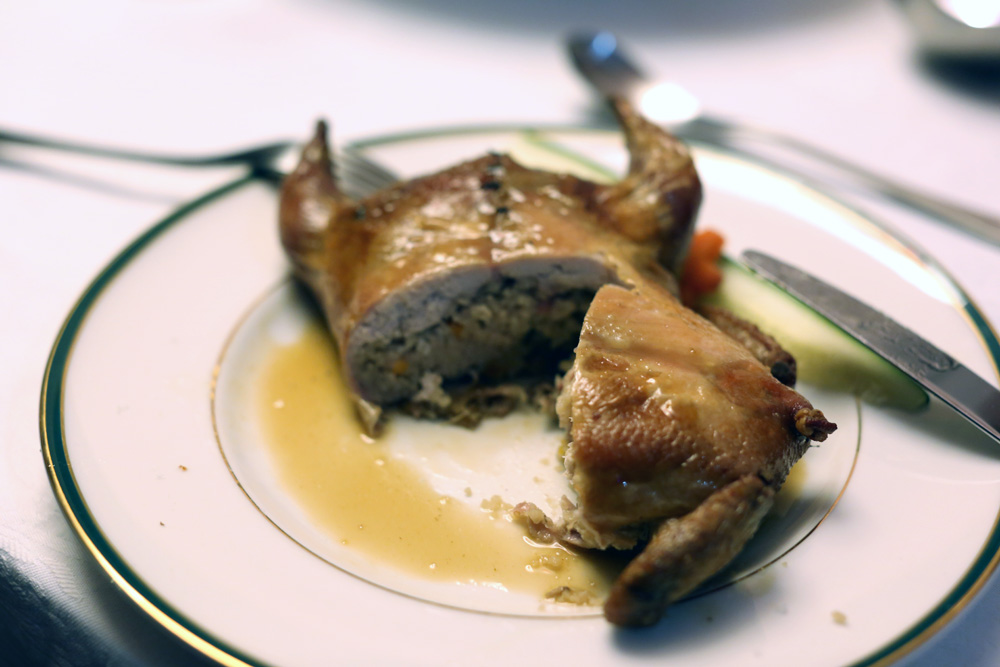
Cut in half to show that it is indeed deboned. The stuffing is couscous with shallots, a brunoise of mushroom, carrot, and celery, and speck. It was injected with stock to help keep the birds plump.
-
 4
4
-
-
Ann_T that piece of Halibut is good enough for Jehovah!
-
Thanks for the discussion Martin and Chris. Chris, that quote from MC is interesting. When I used to baste, I basted with pan drippings, which is part oil and part escaped juices from the bird. Would you get a better result if you only basted with fresh oil? Or do you try to grab only the oil in the drippings to baste with?
-
Can someone comment on the effect of basting? Most old school turkey recipes call for frequent basting of the turkey. I am under the impression that basting slows cooking by (1) increasing evaporation from the skin thus slowing heat absorption, and (2) heat loss through opening the oven door. Does basting actually help the skin crisp up by adding proteins and sugar to the skin?
-
In Australia, a boiler chicken is a retired egg hen. When you cut into the cavity, you can sometimes (well, quite often) find egg embryos. It is not a substitute for rooster.
-
Considering it is getting colder in the North and still cold in the South, I am guessing it is someone in China. Liuzhou perhaps.
-
LR you should watch this episode of "How to cook like Heston" where he teaches you how to make the perfect mash. There is a brief discussion of potato varieties in the earlier part of the video. He is English, so those potatoes are definitely available in the UK! Maybe just not in your area

-
 1
1
-
-
I am not familiar with the varieties you describe. I can tell you that the type of potato you use is critical to how easily it can be mashed. Here in Australia I have had the most success with a variety called Dutch Cream, which is the closest we get to Yukon Gold. It is a type of waxy potato, but it is alone among waxy potato varieties in that it makes a great mash. You are normally better off using a floury potato.
-
What potatoes are you using? Also, are you boiling the potatoes whole, or did you cut them into discs?
-
I think this is the key insight into the difference in texture between SV and PC.But, organoleptically, the meat is completelly different from the 60ºC one. Juiciness and colour changes take place up to around 75ºC, any higher temperature will not change things much for them, whereas the hidrolysis of collagen takes place exponentially faster as we continue to increase temperature. That's why the traditional stew will not be so much different from the pressure-cooked one at around 120ºC, but can be cooked much faster.
-
I should add, polarizing filters come in two types. Linear polarizers and circular polarizers. Linear polarizers should probably not be used with modern cameras because it interferes with autofocus. No problem using it if you don't mind manual focus, or if you pre-focus the shot before you mount the polarizer. Circular polarizers do not interfere with AF, but are expensive

-
Hi Nick, re: refrigerator temperatures I can't seem to find my reference right now. I thought I read it in MC or McGee, but a quick flick through McGee didn't show it up. In any case, if you put hot food in the fridge, it does not warm up the rest of the fridge any more than opening the door would. The thermostat on your refrigerator regulates the temperature and takes care of that.I'm always persuaded by data. Where was the former debunked? and what is your evidence for the latter? I recall looking at the thermal cooling model put together by either Douglas or Nathanm and they came down firmly on the side of using an ice bath rather than just throwing it in the fridge.
Re: bacterial growth I defer to your source. Thank you for pointing that out.
-
Hm, I am not particularly convinced by either argument. The latter argument (re: fridge temperatures) has been debunked. As for rapid chilling for food safety, I think you will find that the risk is minimal if almost nonexistent if you chill in an ice bath as opposed to simply moving the bags from the SV machine directly into the fridge.It is pasteurized, not sterilized so rapid chilling keeps it out of the danger zone when cooling. Besides it allows me to throw it in the fridge without affecting other foods by raising the temperature by putting hot food in there.
-
Not my method. I read about it in Modernist Cuisine. There is a video on how to do it on Youtube:I am intrigued by this method as well as Keith_W's straight injection method.
Trust me, this is much superior to dunking the whole turkey in brine. The downside is that you need to purchase a brining syringe. Or, if you have access to medical equipment like me, you can simply repurpose a 50mL syringe and an 18G needle

-
Why do you need to rapid chill it in an ice bath?Cook at 82C (180F) for 8 hours. Rapid chill in an ice bath.



Dinner! 2013 (Part 6)
in Cooking
Posted
huiray, I have been asked to make a yee sang for Chinese New Year this year. How do you dye your taro yams after deep frying?